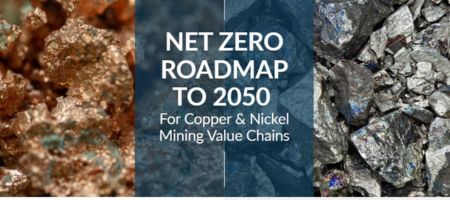Blog
-

-
Manager of Climate Intelligence, Rocky Mountain Institute (RMI)
Jun 19, 2023
We begin with an intriguing question: Can the mining industry produce the minerals and metals that are essential to clean energy technologies, in green and inclusive ways?
The short answer: Not yet. In fact, the mining industry is responsible for 10 percent of global greenhouse gas emissions, including smelting and refining activities. Primary production of minerals and metals is a subset (~1 percent) of the 10 percent. As a key climate solutions provider, achieving the decarbonization of the industry to meet global climate goals will require a dramatic, net-zero transformation. This means reimagining the entire mining ecosystem, ranging from energy, equipment, land use, transport, processing and supply chain management.
Ensuring a just and inclusive transition—in which workers, local communities, and consumers alike benefit—will hinge on elevating mining’s environmental, social and governance (ESG) considerations to mission-critical status.
This will take work. It will require political will, intentional effort, and a collaborative mindset that brings together governments, the private sector, investors, and local communities alike.
Minerals and metals are key for the Paris Agreement, our global climate action mandate
Mining is essential to the low-carbon economy and here’s why: Estimates indicate that more than 3 billion tons of minerals and metals will be needed to achieve the Paris Agreement‘s goals of net-zero greenhouse gas emissions by 2050 via renewables.
Soaring market demand requires increased production, including for copper and nickel, two key inputs for renewable technologies. This could double the annual greenhouse gas emissions in both mature markets such as copper and also high-growth sectors like nickel where volumes will triple to 2050, according to IFC’s recently launched net-zero roadmap for mining.
At the same time, these emission increases will place added stress on the environment surrounding mining locations, as well as on the people who live there.
Some locations with the greatest mineral reserves are also among the most vulnerable to climate change. For instance, 33 percent of the world’s copper reserves are in countries with high water stress. This creates a dilemma since water is a critical mining input.
Similarly, given that 75 percent of global nickel reserves are in countries with high rates of biodiversity, tripling the nickel supply—as IFC’s projections suggest will be needed to reach global climate goals—could heighten the biodiversity risks in mining regions. This would undermine climate-friendly gains in renewables.
Meanwhile, while automation and digitization technologies yield efficiency benefits, they may also replace low-skilled jobs, negatively impacting local employment and livelihoods previously associated with mining.
Leveraging technology to increase shared benefits with local communities
As the mining industry grapples with these issues, identifying and deploying technologies that offer shared benefits for local communities and the environment will be key. The good news is that many low-carbon interventions, such as solar and wind powered operations, deliver environmental and social co-benefits.
Companies are increasingly leveraging these low-carbon approaches, as they seek ways to green their operations while contributing positive local environmental and social impact. To date, 5 GW of renewable energy projects on mine sites have been announced or commissioned, often yielding additional benefits for local communities.
For example, Rio Tinto and Voltalia’s partnering on a solar power plant to supply Richard’s Bay Minerals in KwaZulu-Natal, South Africa, will reduce greenhouse gas emissions while supporting local Black Economic Empowerment (BEE) through an ownership participation agreement that also includes women.
In Chile, home to about 23 percent of the world’s copper reserves, Anglo American’s first-of-a-kind floating solar photovoltaic array at the Los Bronces copper mine reduces the water evaporation from its storage pond by 80 percent. This minimizes reliance on local water sources, a priority at a time when Chile’s water scarcity has become an issue of national security.
Tackling both emissions reductions while also improving other environmental metrics such as reducing water consumption is an increasingly mainstream approach in the industry. For example, South32 secured a sustainability-linked loan on the basis of improving both their emissions and water performance.
There is also an increased focus on embedding a gender lens into mining operations and ensuring that surrounding communities—including women and young people—can benefit from their transition to net zero. This approach is exemplified by De Beers Accelerating Women Owned Micro-Enterprises (AWOME) that supports women with mentoring, networking, business, and life skills training to help them start and grow local businesses.

Concrete ESG performance will be key in the Net Zero transition
As ESG considerations become top-of-mind for many industry stakeholders, demonstrating tangible and measurable ESG commitments on the road to net zero will be an important factor to enable continued growth—and ensure social license to operate at mining sites.
Instruments such as sustainability-linked loans and bonds are gaining traction as a way to incentivize such commitments, by linking achievement of environmental and social targets to reductions in borrowing costs. For example, IFC’s recent $100 million sustainability-linked loan for Anglo American is tied to social performance metrics, including education and job creation, with a focus on women and young people. The company has a stated commitment of 100 percent operational carbon neutrality by 2040.
Companies are increasingly partnering with IFC and other financial institutions to develop robust, transparent ESG performance metrics to guard against growing concerns over greenwashing.
With COP 28 coming up this November, we end as we began, with this question: Can mineral and metal production become clean, inclusive, and green? The answer: Yes, it can, with some help and guidance, along with supportive policies, aligned ESG commitments, and buy-in from public and private stakeholders.
IFC’s net-zero roadmap for mining, produced in collaboration with our partners, outlines strategies that mining companies can use to reduce their emissions and further enhance ESG performance. This will help them take advantage of demand growth for green commodities while contributing important, shared environmental and community benefits along the pathway to a just net-zero world.
Related Content
Building a sustainable future: Affordable green housing in emerging markets
ESG
Mining
Sustainability
Metals and Mining Hold the Key to the Energy Transition. Gender-smart Businesses Can Be the Driver.
ESG
Mining
Sustainability
Did you say, “Women and Girls in Science”? Meet Sally, who proves that women can succeed in STEM
ESG
Mining
Sustainability
Leave a Comment
- IFC
- IFC Sustainable Infrastructure Advisory
- IFC Infrastructure
- IFC Oil, Gas and Mining
- IFC Performance Standards
- IFC Sustainability
- IFC Telecoms, Media, and Technology
- IFC Financial Valuation Tool
- PPP Knowledge Lab
- World Bank Open Data
- World Bank Extractive Industries
- GOXI Sharing in Governance of Extractive Industries


